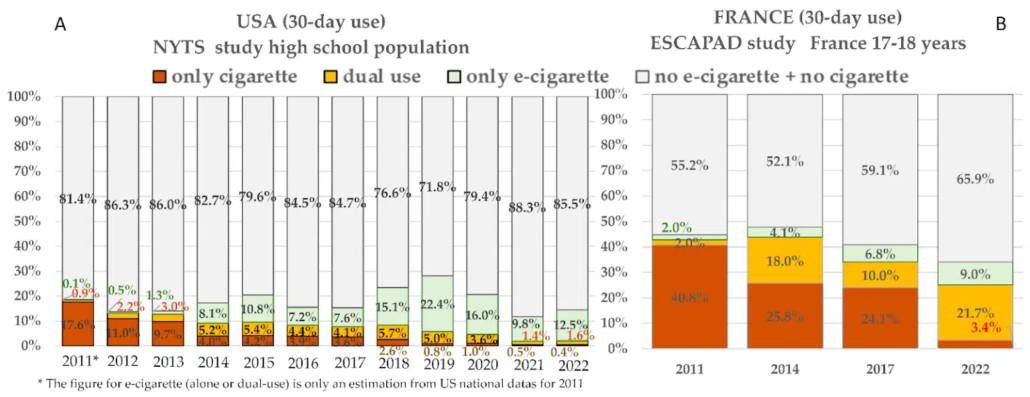Although abstaining from nicotine remains the best option from a medical standpoint, it is crucial to maintain a critical and objective outlook to prevent public health policies that could have counterproductive effects in the effort to control tobacco use.
A study led by renowned researcher Bertrand Dautzenberg has shed light on the complex and often misunderstood phenomenon of vaping among teenagers. Analyzing a series of longitudinal studies, Dautzenberg’s team discovered a significant discrepancy in understanding the impact of vaping on the initiation of cigarette smoking among youth.
The biased approach has led to broad and potentially misleading generalizations about the role of vaping in young people’s smoking behavior, raising serious questions about public health policies based on these studies. Dautzenberg’s research advocates for a more critical and nuanced analysis, crucial for formulating effective tobacco control strategies in the youth population.
The contradiction between the accelerated decline in teenage smoking and the “gateway effect” theory of vaping towards tobacco has been the focus of this pioneering study by a team of French researchers.
The systematic review and critical analysis titled “Systematic Review and Critical Analysis of Longitudinal Studies Assessing Effect of E-Cigarettes on Cigarette Initiation among Adolescent Never-Smokers” was led by Professor Bertrand Dautzenberg of Sorbonne Université and the Institut Arthur Vernes in Paris, along with a multidisciplinary team of experts. It deeply addresses this topic of great relevance for public health policies.
Study Details
The team, including Stéphane Legleye from Ensai & Cesp and Université Paris-Saclay, Michel Underner from Centre Hospitalier Laborit, Philippe Arvers from the 7th Medical Center of the Armies, Bhavish Pothegadoo from Hôpital Maison Lafitte, and Abdelhalim Bensaidi from Hôpital de Nanterre, delved into an in-depth analysis of longitudinal studies to assess the impact of electronic cigarette use on smoking initiation in adolescents who had never smoked before.
The research stands out not only for its comprehensiveness but also for its critical approach to unraveling the complex relationship between vaping and the initiation of smoking, an issue that has generated considerable debate, myths, and concern in the field of public health and the world of tobacco consumption and control.
Despite predictions that vaping would increase smoking among young people, reality has proven otherwise. Additionally, the study has revealed considerable methodological bias in previous studies supporting the bridge effect theory. “After 1,500 hours of work, we have published the dismantling of the 23 articles that claimed that vaping was a gateway to cigarettes for teenagers when the data from the 23 articles explain at most 5.3% of cigarette experimentation and disregard the opposite effect.”
Reality Prevails
In the United States, there was a significant drop in the percentage of teenage smokers, from 19.5% in 2009 to 4.6% in 2020, a much sharper decline than expected. In France, the percentage of teenage smokers decreased from 42% in 2011 to 25.1% in 2022. These trends suggest that vaping might not be acting as a gateway to smoking but rather the opposite.
Dautzenberg and his team’s analysis focused on 23 studies examining the bridge effect of vaping to smoking in teenagers. Surprisingly, they discovered that most of these studies had selected specific subgroups of youth, excluding an average of 74.1% of teenagers related to smoking, and based their general conclusions on these reduced groups.
This meant that the results spoke only of 5.3% of the adolescent smokers from the studied cohorts, which represents only 1.3% of the 129,800 teenagers from the global cohorts.

This discovery raises serious questions about the validity of these studies’ conclusions. According to Dautzenberg’s team, focusing on specific subgroups has generated a “gateway artifact” that distorts the understanding of the real impact of vaping on smoking initiation. Furthermore, the French team observed that young people who started with vaping and then switched to tobacco smoked much less than those who started directly with tobacco.
Clash of Discourses
These findings challenge the prevailing notion that vaping necessarily leads to smoking in teenagers, suggesting instead that it could have a protective effect against the initiation of regular cigarette consumption. However, despite this emerging evidence, the perception of vaping as a gateway to smoking remains a dominant narrative in the media and among policymakers and health officials.
At the very least, Dautzenberg and his team’s work highlights the importance of a careful and critical interpretation of epidemiological data. By questioning methodological assumptions and exploring alternatives to accepted narratives, this study not only contributes to a better understanding of the impact of vaping on teenage smoking but also invites a deeper reflection on how scientific data are interpreted and presented in the realm of public health.
The critical discovery aligns with a broader perspective in scientific research and health policy, where it is often necessary to question and reevaluate existing theories and conclusions in light of new evidence and analysis. In doing so, it reveals a complexity that goes beyond simplistic causal explanations, highlighting instead the multiple factors, including human behaviors and social trends, that influence risk behavior among teenagers.
The “Diversion Effect”
The study concludes by describing the complex landscape in research on the use of electronic and traditional cigarettes among teenagers, highlighting a significant discrepancy between two types of studies: cross-sectional and longitudinal.
Cross-sectional studies, which capture data at a specific point in time, indicate that while the use of traditional cigarettes has decreased among teenagers, the use of electronic cigarettes has increased. This suggests a “diversion effect,” where vaping could be diverting potential tobacco smokers towards its use, instead of towards conventional cigarettes. On the other hand, longitudinal studies, which observe individuals or groups over time, tend to conclude that there is a general “gateway or bridge effect,” where the use of vaping leads teenagers to start smoking traditional cigarettes.
The discrepancy between both types of studies is mainly due to longitudinal studies focusing on small sub-cohorts of individuals who do not smoke tobacco and might transition from vaping to cigarettes. These sub-cohorts, by excluding initial tobacco smokers, represent only a small fraction of the total population and explain a maximum of 5.3% of smoking initiation in teenagers. Additionally, these studies tend to assess only the gateway effect and exclude the possibility of identifying and quantifying a diversion effect from combustible cigarettes by electronic cigarettes.
The study ends by underscoring the need to reconsider the discrepancies between the results of sub-cohorts and the general conclusions of longitudinal studies, which often generalize the existence of a strong gateway effect of vaping to cigarette use in all teenagers. It also notes that the mechanisms that have led to this “scientific dysfunction” must be identified.
Finally, it warns that excessive regulation of vaping among young people, based on a misinterpretation of the results of longitudinal studies, could be harmful to public health and tobacco control.
In this context, it suggests that although abstaining from nicotine remains the best option from a medical standpoint, addressing these discrepancies is crucial to avoid public health policies that could have counterproductive effects in the effort to control tobacco use. The research led by Professor Dautzenberg highlights the importance of a careful and nuanced interpretation of research on vaping and smoking in teenagers and calls for a critical review of the methods and conclusions of existing studies to better inform public health policies.
In perspective, the findings of Dautzenberg’s team offer a new and crucial panorama for a better understanding of the relationship between vaping and smoking in youth. By challenging established narratives and paving the way for more informed and nuanced public health policies for the complex world of public health and smoking prevention, this study serves as an important reminder of the need for critical and rigorous analysis, free from bias and based on a complete and profound understanding of the available data. This implies the responsible development of indispensable scientific standards.

